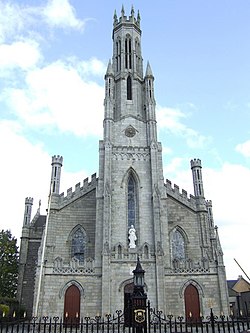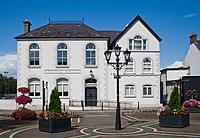Carlow
| Carlow Irish: Ceatharlach | |
| County Carlow | |
|---|---|
 Carlow Cathedral | |
| Location | |
| Grid reference: | S724771 |
| Location: | 52°49’50"N, 6°55’54"W |
| Data | |
| Population: | 13,698 (2011) |
| Local Government | |
| Dáil constituency: |
Carlow-Kilkenny |
| Website: | http://www.carlow.ie |
Carlow is the county town of County Carlow, sitting on the River Barrow, which flows through the town and forms the boundary between counties of Laois and Carlow, thus the town trespasses into its neighbouring county.
Carlow is thousands of years old and pre-dates written Irish history. It has played a major role in Irish history, serving as the capital of the country in the 14th century.
Though County Carlow is the second smallest county in Ireland by area, Carlow Town is the 14th largest urban area in Ireland by population according to the 2011 census, with a population in the town and surrounding area of 23,030.
Its good transport links have allowed this town to become a commuter town for Dublin.
Contents
Name
The name Carlow appears Norse or English but it appears in fact to come from the Irish Gaelic language, the Irish language name being reconstructed for modern purposes as Ceatharlach. Historically, the name was written in English as Caherlagh (1659), Caterlagh and Catherlagh (1654).
There are two main theories about the name of Carlow. The first part of the name may be from the Old Irish word cethrae ("cattle, herds, flocks"), related to ceathar ("four") and therefore signified "four-legged". The second part of the name is the ending -lach, though some have asserted that the name should be Ceatharloch ("fourfold lake").
History
The Carlow county area has been settled for thousands of years, evidence of human occupation extends back thousands of years, the most notable and dramatic prehistoric site being the Browneshill Dolmen - a megalithic portal tomb just outside of Carlow town.
Now part of the diocese of Kildare and Leighlin, several Early Christian settlements are still in evidence today around the county. St Mullin's monastery is believed to have been established around the 7th century, the ruins of which are still in evidence today. Old Leighlin was the site of one of the largest monastic settlements in Ireland and the location for a church synod in 630 AD which determined the date of Easter. St Comhgall built a monastery in the Carlow area in the 6th century, an old church building and burial ground survive today at Castle Hill known as Mary's Abbey. Carlow was an Irish stronghold for agriculture in the early 1800s which earned the county the nickname of the scallion eaters. Famine wiped out a lot of the population, cutting it in half.
Carlow Castle was constructed by William Marshal, Earl of Striguil and Lord of Leinster, c1207-13, to guard the vital river crossing. It was also to serve as the capital of the Lordship of Ireland from 1361 until 1374. This imposing structure survived largely intact until 1814 when it was mostly destroyed in an attempt to turn the building into a lunatic asylum. The present remains now are the West Wall with two of its cylindrical towers.
The bridge over the river Barrow - Graiguecullen Bridge, is agreed to date to 1569. The original structure was largely replaced and widened in 1815 when it was named Wellington Bridge in celebration of the defeat of Napoleon's army by the Duke of Wellington at the Battle of Waterloo in June of that year. The bridge was built across a small island in the river and a 19th-century house was constructed on the bridge - this was for a time occupied by the Poor Clares, an enclosed religious order who still have a convent in Graiguecullen. Another convent belonging to the Presentaion Order of nuns now houses the County Library and beautifully restored, newly opened Carlow County Museum. The Cathedral, designed by Thomas Cobden, was the first Roman Catholic cathedral to be to be built in Ireland after Emancipation in 1829. Its construction cost £9,000 and was completed in 1833. Beside the cathedral, Saint Patrick's College dates from 1793. The College, was established in 1782 to teach the humanities to both lay students and those studying for the priesthood. The Carlow Courthouse was constructed in the 19th century. There are still many old estates and houses in the surrounding areas, among them Ducketts Grove and Dunlecky Manor. St Mullin's today houses a heritage centre.
In 1703 the Irish House of Commons appointed a committee to bring in a bill to make the Barrow navigable, by 1800 the Barrow Track was completed between St Mullin's and Athy, establishing a link to the Grand Canal which runs between Dublin and the Shannon. By 1845 88,000 tons of goods were being transported on the Barrow Navigation. Carlow was also one of the earliest towns to be connected by train, the Great Southern and Western Railway had opened its mainline as far as Carlow in 1846, this was extended further to reach Cork in 1849. The chief engineer, William Dargan, originally hailed from Killeshin, just outside of Carlow. At the peak of railway transport Ireland, Carlow county was also served by a railway line to Tullow.
Public supply of electricity in Carlow was first provided from Milford Mill, approximately 5 miles south of Carlow, in 1891. Milford Mill still generates electricity feeding into the national grid. Following independence in the early 1920s the new government of the Irish Free State decided to establish a sugar-processing plant in Leinster, Carlow was settled on as the location due to its transport links and large agricultural hinterland, favourable for growing sugar beet.
The town is recalled in the famous Irish folk song, Follow Me Up to Carlow, written in the 19th century about the Battle of Glenmalure, part of the Desmond Rebellions of the late 16th century. In 1650, during the Cromwellian conquest of Ireland, Carlow was besieged and taken by Parliamentarian forces, hastening the end of the Siege of Waterford and the capitulation of that city. During the 1798 rebellion Carlow was the scene of a massacre of 600 rebels and civilians following an unsuccessful attack on the town by the United Irishmen, known as the Battle of Carlow. The rebels slain in Carlow town are buried in the 'Croppies Grave', in '98 Street, Graiguecullen.
Places of interest
One of Carlow's most notable landmarks is the Brownshill Dolmen, situated on the Hacketstown Road (R726). The capstone of this impressive Dolmen is reputed to be the largest in Europe.
Carlow Castle was probably built between 1207 and 1213 by William Marshall on the site of a motte erected by Hugh de Lacy, 1st Earl of Ulster in the 1180s. Only the western wall and two towers now survive. It is located on the banks of the River Barrow near Carlow town centre.[1]
The castle is now the imposing centrepiece of a major urban renewal programme.[2]
Ducketts Grove is the ruin's of the Georgian home of the Duckett Family, built circa 1800s. It was taken over by Carlow County Council in 2005, who restored the walled gardens for use by the public as a park. It is situated just off the R418.[3]
Carlow Courthouse is situated at the end of Dublin Street. It was designed by William Vitruvius Morrison in 1830 and completed in 1834. It is built of Carlow granite and gives the impression of being a temple set on a high plinth. The basement contains cells and dungeons. A cannon from the Crimean War stands on the steps.[4]
Carlow Town Hall is situated on the north side of the Haymarket, and was the trading centre for Carlow. A number of other markets were located around the town, including the Potato Market and Butter Market. The Town Hall was designed by the church architect William Hague in 1884.[5]
Milford is a green area on the River Barrow approx 5 miles outside of Carlow town. It is notable as its home to Milford Mill, which was the first inland hydro-electrical plant in Ireland. It began supplying Carlow town with power in 1891.[6]
Economy
Carlow industry has come a long way since the early 20th century, when the town became the centre of Ireland's slow process of industrialization with the creation of the Irish Sugar Company - then the cutting edge of industry in Ireland, the sugar factory opened in 1926 as a private enterprise and was eventually nationalised before reverting to private ownership. The sugar factory was closed on March 11, 2005 as the management of the parent company Greencore decided that it was no longer economical to run the factory nor was it viable to upgrade the facility. The country's last remaining plant at Mallow, County Cork closed in 2006.
One of the traditional, principal employers in Carlow was Braun, which had a large factory producing mostly hair dryers and electric toothbrushes, however this closed in 2010. Burnside is also a principal employer in the area which produces hydraulic cylinders. The Institute of Technology is also a significant employer in the town. Since opening its doors in October 2003 Fairgreen Shopping Centre has also played a large part in employment in the area, with Tesco, Heatons, Next, New Look and River Island being the main tenants of the shopping centre. Nonetheless, the town shares problems associated with other provincial towns in Ireland - the inability to attract significant new industry. Pharmaceutical giant Merck & Co. intends to build a new vaccine manufacturing plant in Carlow.[7]
Churches
- Roman Catholic: Carlow Cathedral dedicated to 'Our Lady of Assumption', was started in 1828 and completed in 1833, in Gothic style. The main architect was Thomas Cobden, but the cathedral was the brain-child of the Roman Catholic Bishop of Kildare and Leighlin, James Doyle, a prominent champion of Catholic Emancipation, who died the year after the cathedral was opened and is interred in its walls. A sculpture, by John Hogan, in memorial to the bishop was finished in 1839.[8] An unidentified baby was left here on January 22, 2010.[9][10]
- Church of Ireland: St Mary’s dates from 1727, though the tower and spire, built to a height of 59 m (195 ft) were added in 1834. The interior retains its traditional galleries and there are several monuments, including some by neo-classical architect, Sir Richard Morrison.[11]
Sport
- Racquetball: Carlow Racquetball club, set up in 1978
- Gaelic Athletics Association:
- Eire Og GAA Club
- Asca GAA Club
- O'Hanrahans GAA Club
- Dr Cullen Park; a GAA stadium in Carlow
- Carlow Boxing Club]]
- County Carlow Football Club]]
- Carlow Golf Club
- Carlow Rowing Club
- Carlow Rugby Club
- Carlow Tennis Club
- Carlow Jaguar Scooter Club founded 1979, one of the longest running scooter clubs
- FC Carlow
Outside links
| ("Wikimedia Commons" has material about Carlow) |
References
- ↑ "Carlow Castle". Carlow Town.com. http://www.carlowtown.com/info_tosee.asp. Retrieved 2007-12-09.
- ↑ "Carlow Castle, Carlow town". Carlow Tourism - Castles. http://www.carlowtourism.com/castles.html. Retrieved 2007-12-09.
- ↑ "Duckett's Grove". carlowgradentrail.com. http://www.carlowgardentrail.com/ducketts_grove.htm. Retrieved 2009-12-05.
- ↑ "Carlow Courthouse". Carlow Town.com. http://www.carlowtown.com/info_tosee.asp. Retrieved 2007-12-09.
- ↑ "Carlow Town Hall". Carlow Town.com. http://www.carlowtown.com/info_tosee.asp. Retrieved 2007-12-09.
- ↑ "Milford". Carlow County Museum. http://www.carlowcountymuseum.com/collections/industry/Pages/electricity.aspx. Retrieved 2013-05-23.
- ↑ Merck invests EUR200m in Carlow facility story dated 27-11-2007 on ENN website. Retrieved 2008-10-16
- ↑ "Carlow Cathedral". Carlow Town.com. http://www.carlowtown.com/info_tosee.asp. Retrieved 2007-12-09.
- ↑ RTÉ. "Baby left in Carlow Cathedral". Friday, 22 January 2010 22:10
- ↑ The Irish Times - Last Updated: Friday, January 22, 2010, 21:58. "Baby abandoned in Carlow Cathedral". PAMELA NEWENHAM.
- ↑ "St Mary's Church". Carlow Town.com. http://www.carlowtown.com/info_tosee.asp. Retrieved 2007-12-09.


